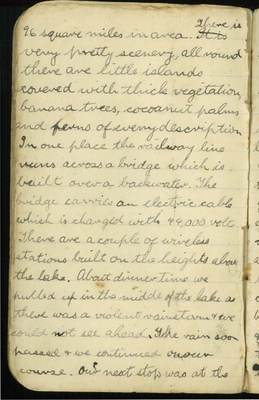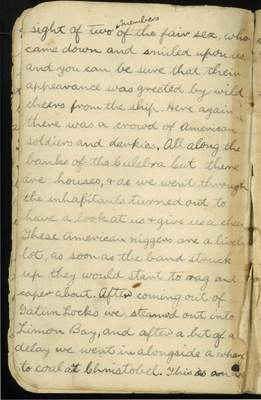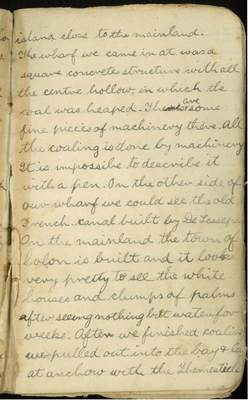Pages
Page 12
96 square miles in area. There is very pretty scenery, all round there are little islands covered with thick vegetation, banana trees, cocoanut palms and ferns of every description In one place the railway line runs across a bridge which is built over a backwater. The bridge carries an electric cable which is charged with 44,000 volts. There are a couple of wireless stations built on the heights above the lake. About dinner time we pulled up in the middle of the lake as there was a violent rainstorm & we could not see ahead. The rain soon passed & we continued on our course. Our next stop was at the
Page 13
Gatun Locks. These are the largest set of locks of the three. We sailed into the first lock which is on a level with the lake. The water is pumped out and we sink down to the level of the next lock, and so on until we are down on the sea level again. All along the edge of each lock crowds gathered to see us pass. On the edge of Miraflores Locks a small crowd of soldiers collected, and of course as soon as we came in they started to cheer and before long showers of coins badges and other souveniers were being exchanged between the yanks & our chaps. When we arrived at the Pedro Miguel Locks our eyes were gladdenend by the
Page 14
sight of two members of the fair sex, who came down and smiled upon us and you can be sure that their appearance was greeted by wild cheers from the ship. Here again there was a crowd of American soldiers and darkies. All along the banks of the Culebra but there are houses, & as we went through the inhabitants turned out to have a look at us & give us a cheer. These American niggers are a lively lot, as soon as the band struck up they would start to rag and caper about. After coming out of Gatun Locks we steamed out into Limon Bay, and after a bit of a delay we went in alongside a wharf to coal at Christobel. This is on an
Page 15
island close to the mainland. The wharf we came in at was a square concrete structure with all the centre hollow in which the coal was heaped. There are some fine pieces of machinery there. All the coaling is done by machinery It is impossible to describe it with a pen. On the other side of our wharf we could see the old French canal built by De Lesseps. On the mainland the town of Colon is built and it looks very pretty to see the white houses and clumps of palms after seeing nothing but water for weeks. After we finished coaling we pulled out into the bay & lay at anchor with the Themesticles
Page 16
Of course there was a lot of unrest when we were told that we were not going to get shore leave but after we came out into the bay we were informed that we were to be taken ashore in the boats and given a swim. Well things were fixed up & went ashore & had a stroll round on America. We landed on a beach fringed with cocoa nut palms, and it seemed funny to see a crowd of naked men running in & out of the jungle. Several of us got together & went into the jungle in search of cocoanuts. We looked round, for a low tree, and before long we slashing at the nuts




